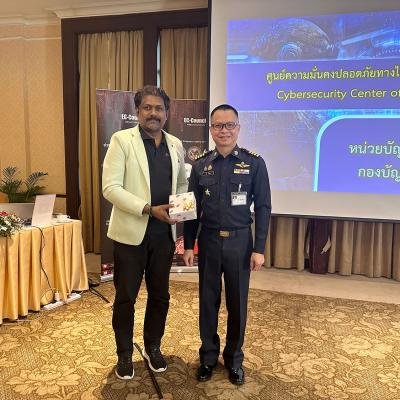In the ever-evolving landscape of cybersecurity, certain adversaries have gained notoriety for their stealthy tactics and relentless attacks. One such formidable adversary is "Mimikatz." This blog post embarks on an extensive journey to uncover the world of Mimikatz, delving deep into its origin story, intricate functionalities, and, most importantly, the essential strategies and practices required to defend against this persistent and dangerous cyber threat.
The Genesis of Mimikatz
To understand the true nature of Mimikatz, we must begin at its origin. Benjamin Delpy, a French security researcher and developer, is the mastermind behind this tool. Initially, Mimikatz started as an educational project, intended to unravel the intricacies of Windows authentication protocols and vulnerabilities. However, over time, this seemingly innocuous exploration metamorphosed into a potent offensive tool capable of extracting sensitive information from Windows systems.
Crucially, it is essential to recognize that Benjamin Delpy's original intentions were not malevolent. Instead, he sought to shed light on the security flaws within Windows, with the aim of assisting security professionals and organizations in strengthening their defenses. Unfortunately, the power and potential of the tool eventually caught the attention of cybercriminals.
Deciphering Mimikatz's Inner Workings
Mimikatz's allure to attackers lies in its unparalleled ability to exploit a fundamental aspect of Windows security: the Local Security Authority (LSA) subsystem. The LSA manages various security policies, including the storage of sensitive data such as password hashes, Kerberos tickets, and plaintext credentials in memory. To unveil this trove of information, Mimikatz employs various techniques, rendering it a formidable adversary.
- Pass-the-Hash (PtH) Attack: In this technique, Mimikatz extracts password hashes from memory. Armed with these hashes, attackers can authenticate themselves as a user without ever needing to know the actual password. This method effectively bypasses the need for the authentic password, enabling covert access.
- Pass-the-Ticket (PtT) Attack: Beyond hashes, Mimikatz can deftly retrieve Kerberos tickets from memory. Attackers can then skillfully reuse these tickets to gain unauthorized access to services, further deepening their intrusion.
- Overpass-the-Hash Attack: An insidious technique, Overpass-the-Hash empowers Mimikatz to change a user's password without possessing knowledge of the original password. This effectively places attackers in control of user accounts, a power rife with potential danger.
- Golden Ticket Attack: The pièce de résistance of Mimikatz's capabilities, the Golden Ticket attack involves the skillful forging of Kerberos tickets for any user, including those holding highly privileged accounts. This grants attackers access to systems and resources that would typically be off-limits, paving the way for extensive mischief.
Real-World Chaos Wrought by Mimikatz
Mimikatz is not confined to theoretical discussions; it has been at the center of significant chaos and destruction in the realm of cybersecurity. Numerous high-profile cyberattacks have featured the deployment of Mimikatz, underscoring its undeniable significance:
- WannaCry Ransomware: Perhaps one of the most notorious chapters in Mimikatz's dark history is its involvement in the WannaCry ransomware attack. This catastrophic event leveraged vulnerabilities in Windows systems to unleash widespread panic and financial losses.
- Targeted Espionage: Advanced threat actors have harnessed Mimikatz as their weapon of choice to steal sensitive data and conduct espionage. These attacks have targeted government organizations, private enterprises, and even critical infrastructure, underscoring the pervasive threat posed by this tool.
- Credential Theft: At its core, Mimikatz excels at the sinister art of harvesting login credentials from memory. This functionality alone makes it a formidable threat capable of compromising individuals and organizations alike, leaving them vulnerable to a multitude of cyber-ills.
Strategies for Defending Against Mimikatz
Given the potential for extensive damage that Mimikatz presents, a multi-pronged defense strategy is essential. Let's explore key strategies and best practices that organizations can adopt to shield their systems and data from this nefarious adversary:
- Patch Management: Maintaining up-to-date systems with the latest security patches is paramount. Many of the vulnerabilities that Mimikatz exploits can be mitigated through timely patching.
- Least Privilege Access: Implementing the principle of least privilege organization-wide is a crucial practice. By limiting user access rights to the bare minimum required for their roles, organizations can significantly reduce the potential impact of credential theft.
- Credential Guard: Enabling Windows Credential Guard is a pivotal security measure that helps protect sensitive credentials from Mimikatz. Ensuring that Credential Guard is enabled on your systems is paramount.
- Endpoint Detection and Response (EDR): Deploying EDR solutions is a proactive measure that enables organizations to monitor and detect suspicious activities and processes. EDR tools can identify telltale signs of Mimikatz usage and trigger a timely response.
- Strong Authentication: Enforcing strong authentication methods like multi-factor authentication (MFA) serves as a formidable defense against Mimikatz and similar threats. MFA introduces an additional layer of security, making it significantly more challenging for attackers to gain unauthorized access.
- User Education: Raising awareness among employees about the dangers of phishing attacks, a common vector for Mimikatz and similar threats, is paramount. Encouraging good password hygiene and emphasizing the importance of not reusing passwords across multiple accounts can significantly enhance an organization's security posture.
Examples and Evidence:
Example 1: WannaCry Ransomware Attack
Evidence: The WannaCry ransomware attack in May 2017 is a prime example of how Mimikatz was used in a devastating cyberattack. WannaCry exploited a Windows vulnerability (EternalBlue) and used Mimikatz to escalate privileges and propagate within networks. The attackers used Mimikatz to extract credentials from compromised systems, allowing them to move laterally and infect thousands of computers globally. The attack resulted in significant financial losses, affecting organizations and individuals alike.
Example 2: Targeted Espionage
Evidence: Advanced threat actors, often state-sponsored, have been known to employ Mimikatz in targeted espionage campaigns. While specific incidents may not always be publicly disclosed due to their sensitive nature, reports from cybersecurity firms and government agencies highlight the use of Mimikatz in such activities. These actors use Mimikatz to gain unauthorized access to critical systems, exfiltrate sensitive data, and maintain persistence within compromised networks.
Example 3: Security Research and Demonstrations
Evidence: Security researchers and penetration testers frequently use Mimikatz to demonstrate vulnerabilities in Windows systems. These demonstrations serve as evidence of Mimikatz's effectiveness in extracting sensitive information. Many security conferences, such as DEFCON and Black Hat, have featured presentations showcasing how Mimikatz can be used to compromise systems. These demonstrations are invaluable for raising awareness about the threat posed by Mimikatz.
Example 4: Mimikatz's Inclusion in Pentesting Tools
Evidence: Mimikatz's effectiveness has led to its inclusion in legitimate penetration testing and red teaming tools. Tools like Metasploit and Cobalt Strike incorporate Mimikatz modules to simulate real-world attacks and help organizations assess their vulnerabilities. The fact that security professionals use Mimikatz as part of their testing toolkit underscores its significance as a cyber threat.
Example 5: Credential Dumping in Cyber Incidents
Evidence: In numerous cyber incidents and data breaches, evidence of credential dumping—often involving Mimikatz—has been uncovered. Security investigators have identified traces of Mimikatz usage in compromised systems where attackers sought to harvest credentials for unauthorized access. While these incidents vary in scale and impact, they all underscore the pivotal role that Mimikatz plays in credential theft.
Example 6: Public Exploits and Vulnerability Disclosures
Evidence: The discovery and disclosure of vulnerabilities related to Mimikatz reinforce the ongoing threat it poses. Researchers and cybersecurity experts routinely identify and report vulnerabilities in Mimikatz itself or in the Windows components it exploits. These findings emphasize the need for vigilance and timely patching to defend against Mimikatz-based attacks.
Conclusion
In the ever-evolving landscape of cybersecurity, where threats continually evolve and adapt, it is paramount for organizations to remain vigilant and well-prepared. The journey of "Unmasking Mimikatz: Understanding, Defending, and Mitigating a Stealthy Cyber Threat" has shed light on the formidable nature of Mimikatz and the critical importance of comprehending, defending against, and mitigating this stealthy cyber threat.
As a leading cybersecurity company, DigiALERT understands the ever-present danger that tools like Mimikatz pose to our clients and the broader cybersecurity community. We recognize that knowledge is the cornerstone of effective defense, and this blog post has aimed to empower our clients with the information needed to safeguard their digital assets.
Our commitment to safeguarding our clients extends beyond awareness. We employ cutting-edge technologies, innovative solutions, and a team of dedicated experts to proactively defend against threats like Mimikatz. We remain at the forefront of cybersecurity research, continuously updating our defenses to counter evolving threats.
In the face of relentless adversaries, we emphasize the importance of a holistic cybersecurity strategy. This strategy encompasses not only robust technological defenses but also a culture of cybersecurity awareness within organizations. Employee education, proactive monitoring, timely patch management, and the use of advanced security tools are all integral components of a comprehensive defense.
At DigiALERT, we stand ready to partner with our clients to fortify their defenses, respond swiftly to emerging threats, and mitigate the risks associated with tools like Mimikatz. Together, we can navigate the complex cybersecurity landscape, ensuring that your digital assets remain protected and your organization resilient in the face of evolving cyber threats.
In conclusion, the unmasking of Mimikatz is a reminder that cybersecurity is an ongoing battle—one that we are fully committed to winning on behalf of our clients. Your security is our priority, and with DigiALERT by your side, you can navigate the digital world with confidence and peace of mind.







